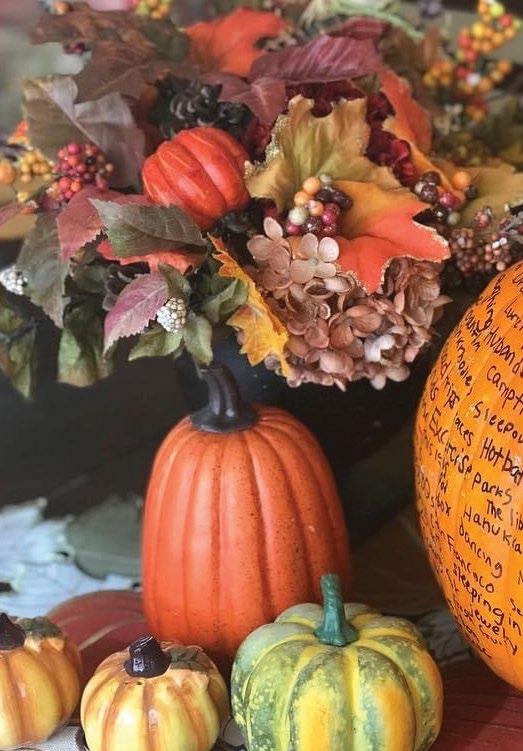
4 minute read
Gratitude Pumpkins
Creating a Gratitude Pumpkin; An Innovative Approach To Celebrating The Season While Practicing a Little Gratitude
by Jenna Drennen
Advertisement

2020 has been challenging. The well-being, global pandemic and social discourse increase pervading all aspects of everyday life resilience, left parents and kids alike consumed strengthen with fear and anxiety. For those of us social struggling with stress and uncertainty, relationships, acknowledging or fostering thoughts and reduce of gratitude can seem difficult or even stress and absurd. As we face adversity, it feels depression. When natural and even necessary to fixate on the practice becomes the negative as a means of overcoming rote, it inevitably increases the obstacles we encounter, but in generosity, compassion, and a times of crisis, taking time to give greater capacity for joy. Studies thanks goes a long way.
Allowing for gratitude in our everyday lives does not necessitate turning a blind eye to negative feelings or difficult situations. Instead, it allows us to better cope with distress by not losing sight of the good, which increases our optimism and ability to stay grounded. Researchers have identified physical, emotional, social, and moral benefits of practicing gratitude. Whether it be keeping a daily gratitude journal or integrating gratitude rituals into daily life, these exercises have been shown to improve well-being, increase resilience, strengthen social relationships, and reduce stress and depression. When the practice becomes rote, it inevitably increases generosity, compassion, and a greater capacity for joy. Studies suggest habitually practicing gratitude can even contribute to a stronger immune system, lower blood pressure, and improved sleep. As I struggled to find novel and creative ways to encourage my own family to practice gratitude, we began to establish a fun family tradition kick-starting the fall season each year. Our annual gratitude pumpkin allows us to take a mindful moment to thoughtfully document all that we are grateful for while having a little fun in the process.
To inspire and encourage my family to consciously focus on gratitude practices, I shared with them the ways this daily activity alters the neurochemical framework of the brain, essentially “rewiring” it. When the brain experiences gratitude, the areas associated with reward, morality, interpersonal bonding, and positive social interactions are activated. When this occurs consistently, gratitude has the capacity to increase neurochemicals such as dopamine, serotonin, and oxytocin associated with feelings of happiness and connection. The more frequently and consistently we practice gratitude, the more we can build upon and solidify the brain’s neurostructural changes linked to increased happiness and overall well-being.
Unfortunately, making a conscious effort to take a daily inventory of what we are grateful for doesn’t always come naturally, especially for kids, who are still learning to regulate emotion and often confuse their privileges with their rights. As humans, we are wired to notice pain or threats within our environment, which is necessary for our survival. Consequently, establishing ways to regularly acknowledge all we are grateful for can be an uphill battle. Despite this, gratitude is a skill that becomes easier and more automatic with practice. Designing family gratitude projects that inspired my family to engage in this practice proved tricky, but I began to integrate our shared love of fall and into my brainstorming process, and we began to create an annual “gratitude pumpkin.”

My family gathers around a pumpkin with black sharpies in hand and devotes some time to taking a mental inventory of all that we are grateful for, essentially “counting our blessings.” We document each item on the pumpkin’s surface. Whether the thing is something as frivolous as “cheesecake,” or “google maps,” or a concept as complex or significant as “hope,” or “sobriety,” every concept gets equal representation on the pumpkin. Completely filling the large pumpkin takes thoughtful effort, and we take pleasure in sharing and acknowledging the items for which each of us is grateful. It is especially rewarding to behold the finished product, brimming with our words and rich with all of the joys we share as a household. We keep our gratitude pumpkin displayed throughout the fall season, frequently adding to it as a new item presents itself. It serves as a constant visual reminder to be grateful.
Our words have power, and collaborating on a project highlighting the words that bring us hope and joy illuminates them and perhaps allows us to more readily recognize the aspects of our lives that are worthy of appreciation and acknowledgment. Our family looks forward to decorating our gratitude pumpkin every year, not just because it is a celebration of the season, but also because it is a celebration of ourselves and the beautiful life we get to share.
Jenna lives in Firestone with her husband, two kids, and a house full of animals. She enjoys, running, gardening, and climbing mountains in her spare time.










